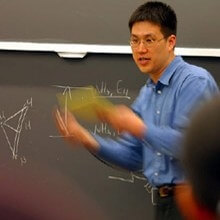News
CAMBRIDGE, Mass. – August 24, 2009 – Donhee Ham, whose revolutionary miniaturization of a nuclear magnetic resonance (NMR) system to handheld size could bring lifesaving changes in biomolecular sensing and disease screening, has been named Gordon McKay Professor of Electrical Engineering and Applied Physics in Harvard University's School of Engineering and Applied Sciences, effective July 1, 2009.
Ham, 35, was previously John L. Loeb Associate Professor of the Natural Sciences at Harvard, a position he held since 2007.
"The appointment of Donhee Ham, who arrived as a junior faculty member in 2002, helps fulfill SEAS's long-term plan of boosting its presence in electrical engineering," says Cherry A. Murray, dean of the Harvard School of Engineering and Applied Sciences. "Donhee's nearly encyclopedic understanding of physics and solid-state circuits has led to creative and innovative applications in diverse fields such as biotechnology and medicine. His 'pocket NMR' and high-speed nanowire circuits are just two examples of how much engineering continues to transform science and everyday life."
Ham is well known for his invention of a groundbreaking single-silicon-chip, handheld NMR system that is much smaller and cheaper than the instruments in use today. Many scientists now believe that Ham's breakthrough pocket NMR can radically change biosensing, medicine, and even quantum computing, introducing cheap, practically disposable NMR devices into every laboratory. For this pocket NMR work, Ham was recognized in August 2008 by Technology Review magazine as among the world's top innovators under the age of 35.
Ham is also known for his work on solitons, a bell-shaped waveform that can travel through nonlinear media without deformation. The unique physics of solitons has captivated scientists for more than 170 years. Ham is particularly interested in electromagnetic solitons, a form usable in modern electronics, and built, for the first time, circuits that can autonomously and robustly fire a stable train of electromagnetic soliton bursts. This work, breaking new ground by taming solitons' unruly nature, brings solitons into the realm of real-world applications: Ham's solitons, for instance, can be used to measure a rapidly changing signal at every trillionth of a second.
Ham is known for his deep and diverse research repertoire. Combining a panoramic grasp of physics with creative circuit engineering, Ham has pushed the intellectual and application boundaries of solid-state circuits, from traditional applications in communication and computation to new areas including one-dimensional plasmonics, biotechnology and medicine, CMOS electrochemistry, quantum computing, and fundamental study of electron-electron interactions in low-dimensional nanoscale conductors.
Ham has attracted top students to Harvard, including top-ranked students from world-class universities, and gold medalists from the U.S. Intercollegiate Physics Competition and the International Physics Olympiad.
Ham earned a B.S. in physics from Seoul National University, South Korea, in 1996, where he graduated summa cum laude, winning the Valedictorian Prize, Presidential Prize, and Physics Gold Medal. Following a year and a half of mandatory service in the Korean Army, he went to the California Institute of Technology, where he received an M.S. in physics in 1999, working on relativistic astrophysics, and a Ph.D. in electrical engineering in 2002, winning the Charles Wilts Prize for the best thesis in electrical engineering. His doctoral work examined the statistical physics of electrical circuits.
Ham joined Harvard as an assistant professor in 2002 and was named associate professor in 2006.
Cutting-edge science delivered direct to your inbox.
Join the Harvard SEAS mailing list.
